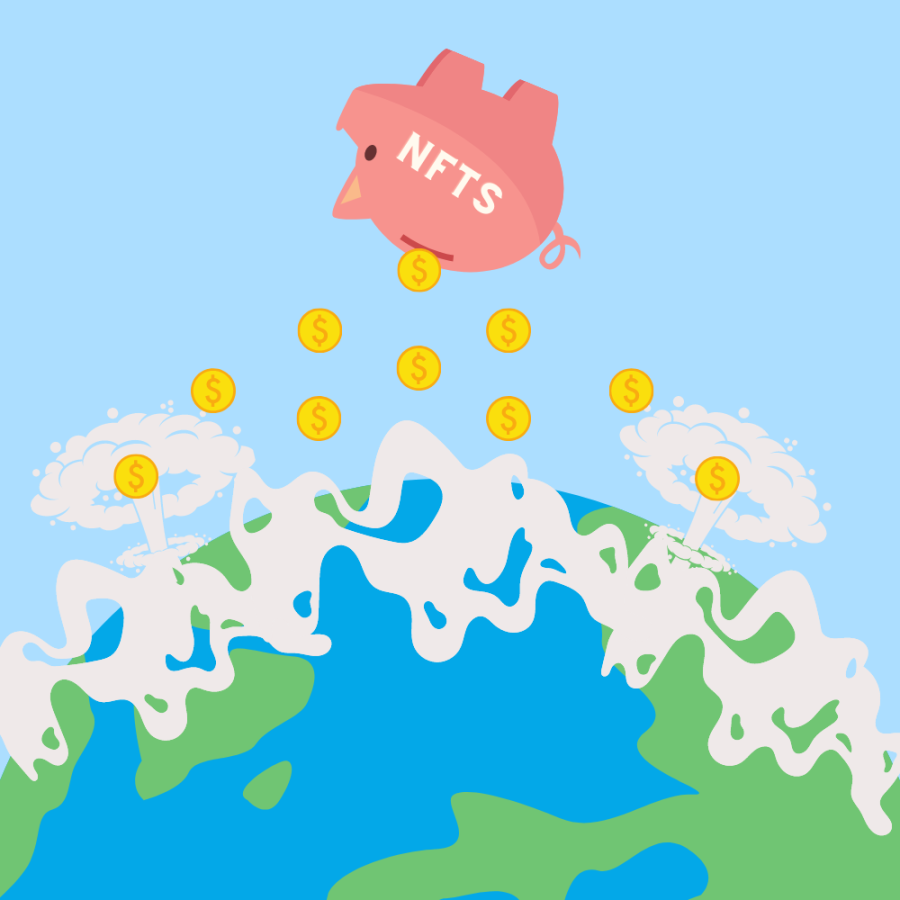NFTs are ruining the environment
NFT related transactions are generating enough pollution to damage the environment.
In a world that is constantly evolving, it is understandable that people struggle to find modern solutions to their modern problems. One of society’s newest developments, cryptocurrency, is an attempt to create a worldwide currency through buying and selling countless valuables online. Non-Fungible Tokens (NFTs) are the most recent result of this trend and allow users to buy or sell ownership to a unique digital design. However, these specialized images are not nearly as groundbreaking as they look – they actually leave a large carbon footprint behind, which is a massive contributor to the environment’s destruction.
To anyone unfamiliar with the world of cryptocurrency, the process may seem complicated; however, they should note that similar systems have been around for decades. Many 20th century kids grew up spending their spare change on baseball cards, which they then traded with other children to acquire their most-wanted cards.
This process is very similar to cryptocurrency – participants purchase quantities of Ethereum (an online token similar to Bitcoin) that they can then use to buy NFTs and other oddities to trade online. Every person who buys an NFT is paying to mint the image, simply meaning that they have purchased ownership. Oftentimes many people want to buy the same design, which is what makes the price fluctuate.
However, the transaction between Ethereum and NFTs has proven to be highly destructive to the environment. Although many steps in the trading process are unknown, Digiconimest, a widely cited platform dedicated to providing cryptocurrency statistics, estimates that a single purchase of Ethereum releases 148.43 kilograms of carbon dioxide into the atmosphere and that 62,830,000,000 kilograms of carbon dioxide are produced each year – nearly equivalent to the combined carbon emissions of Montenegro and Serbia.
But why does one transaction produce so many emissions? Cryptocurrency chains such as Ethereum (one of the main tokens responsible for pushing Ether) use a Proof-Of-Work system, which uses a lot of energy to complete purchases. A single Ethereum transaction requires 266.13 kilowatts hours, which can power the average American household for nearly nine days.
However, there are ways to prevent such highly destructive behavior. If one is interested in purchasing the digital images but unwilling to contribute to the massive carbon footprint left behind, there are other methods of currency that can be used to purchase NFTs. Chains that use proof-of-stake energy instead of proof-of-work require less energy, making them much safer to use. Solana, Algorand, Cardano, and Tezos are all energy-efficient chains that use this system and still support NFT trading.
Although a digitized economy may seem like a brilliant idea, the reality is that the emissions produced from each transaction do more harm than good. Even though there are other chains that do not have nearly as many repercussions, the old-fashioned ways still seem to be the best when it comes to exchanging art. Meet up with local artists, visit art galleries, and purchase pieces in person; these failsafe strategies are sure to be much more environmentally friendly.









Andrew Mallo • Mar 31, 2022 at 9:42 pm
This article only mentions the use of Solana and other NFT systems that use Proof of Stake – which largely cut down on the use of any carbon emissions. The largest NFT trading site, Opensea, recently released that in April they will be adding Solana to their marketplace, which will not only bring more attention to the platform, but hopefully cut the amount of Ethereum-ran projects on the Blockchain. I also think another interesting topic would be the emission from Crypto-mining. There are thousands of acres of land, all dedicated to the mining of Bitcoin and ETH. Another topic to touch on could be the release of ETH 2.0. It is supposedly releasing sometime this summer and should greatly reduce the amount of carbon emissions as these transactions will be on a Proof of Stake platform, similar to Solana. Lastly, could you touch upon the development of Smart Contracts? Many new ETH project developers are using upgraded ERC-721A contracts, do these have any affects on the amount of carbon emissions coming from minting and trading?